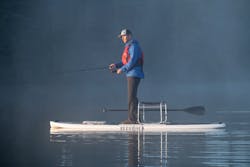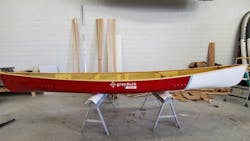By Karen Hanna
If the experiences of one entrepreneur are any guide, efforts to overcome the pitfalls of overseas manufacturing come with their own set of challenges.
“We’re starting to build boats, and we’re bringing in younger people who we’re going to be teaching how to build boats,” said Bossen, who, along with two employees, is working to build canoes in Roseville, Minn., near the Boundary Waters Canoe Area Wilderness. “Having those skill sets around, whether it’s working with composites, or whether it’s specifically in terms of boat building, I think having that skill set in the U.S. is just something that is important.”
Bossen’s company — a relative fledgling that started as a supplier of foam stand-up paddleboards (SUPs) made of EPS foam — is about a year into manufacturing its own canoes, using a process that he believes has relevance for the aerospace and other industries.
“We’re using resin-infusion to build our hulls, so that allows us to lay in all of our cloth dry into the mold, and, then as the very last step, we re-introduce resin through a vacuum process,” he said.
The materials Grey Duck Outdoor uses — wood, vinyl ester, aramid, Kevlar and carbon-fiber composites — all come from U.S. suppliers.
It’s a big change for a small company that like so many others has navigated rough waters in recent years.
Begun in 2016, the company originally offered just one type of product — its SUPs, which it sourced entirely from China.
“I had been there multiple times,” Bossen said. “I’ve worked closely with factories and had found that to be a very positive thing, very easy to manage.”
But the COVID-19 pandemic called all that into question. Just as people were desperate to find new, safe fresh-air diversions, cascading supply chain disruptions squeezed availability of outdoor gear — including Grey Duck Outdoor’s SUPs.
Costs went up, but quality fell.
“We’re obviously super-seasonal, like if you’re selling paddleboards in Minnesota, you’ve got probably an 8- to 12-week window where things are really moving, and so we missed some opportunities, for sure. There was definitely lost sales,” he said.
Global problems took on new relevance. In talking about expanding beyond SUPs, Bossen ticked off issues thousands of miles from Minnesota, including Russia’s invasion of Ukraine and the tensions between Taiwan and China.
“As somebody who’s got all of their sourcing out of China, you can just see that there’s risks in your Asian sourcing, no matter what, but it just became much more evident in the last two years that having some diversification was just a good business decision,” Bossen said.
He teamed up with a canoe maker in Quebec to co-brand a canoe, then began considering doing more, after a chance encounter with an experienced canoe maker in Minnesota.
“We started to get together, and that led to a larger discussion in terms of whether we should actually be building some of our canoes here in Minneapolis,” Bossen recalled.
He took the plunge.
For now, he’s aiming to manufacture between 50 and 100 boats a year.
But he acknowledged he and his team still are finding their sea legs. As of late January, they had made about 20 canoes.
“2022 is definitely the best year we had in terms of really being proud of what we were doing, but it was definitely the most difficult year. We made a lot of mistakes. We got punched in the face a bunch of times,” Bossen said. “From a financial perspective, it was the most difficult year that we’ve been through.”
As an example of the company’s growing pains, he recounted one canoe that got stuck in the mold. That cost the team weeks.
Had the canoe been sourced overseas, workers there might have made similar mistakes — but their customers at the far end of the supply chain would have never heard the details.
“It’s just much more tactile in terms of your ability to really see the process and what it takes to actually manufacture something,” he said.
In making products in-house, Bossen said he’s more aware of what can go wrong. He’s also limited in how quickly he can scale up, and by the skills of the workers that he’s able to hire.
In some ways, it’s a rockier ride.
“It’s not something you can just turn on in a year and see how it goes,” the 46-year-old Bossen said. “I looked at it as a multi-year commitment—a 5- to 10-year commitment. I’m looking at it in terms of decades, not in terms of this year or next year.”
To other entrepreneurs contemplating nearshoring products, he urged patience. Suppliers, he said, should learn how to repair and service their goods first, then ease into manufacturing them.
“I think you really have to want to do some manufacturing here, to go down that path, and [having] some expertise in-house that really kind of understands and knows the processes and what you’re trying to achieve is really important,” Bossen said.
While the experience of in-house manufacturing presents new challenges, Bossen takes pride in where Grey Duck Outdoor is headed. He has control over quality and his intellectual property, and he said he believes he’s giving back, because he’s created jobs, both personally and indirectly, all along the chain of supplies for his company’s canoes.
Eventually, he said he hopes Grey Duck Outdoor’s portfolio is balanced between U.S.-made canoes and China-made SUPs.
“As Americans who want some durability in supply chains, it’s an important step that we need to take because … some of what we’re doing with canoes, you could do in other industries. …” he said. “And so having some experience in building composite components can translate into other industries. If the time came where we needed to build other things, we have the skill set to do that.”
“I’m happy to have created an opportunity for people to use their hands and to really, truly just build products here.”
Karen Hanna, senior staff reporter
About the Author
Karen Hanna
Senior Staff Reporter
Senior Staff Reporter Karen Hanna covers injection molding, molds and tooling, processors, workforce and other topics, and writes features including In Other Words and Problem Solved for Plastics Machinery & Manufacturing, Plastics Recycling and The Journal of Blow Molding. She has more than 15 years of experience in daily and magazine journalism.


